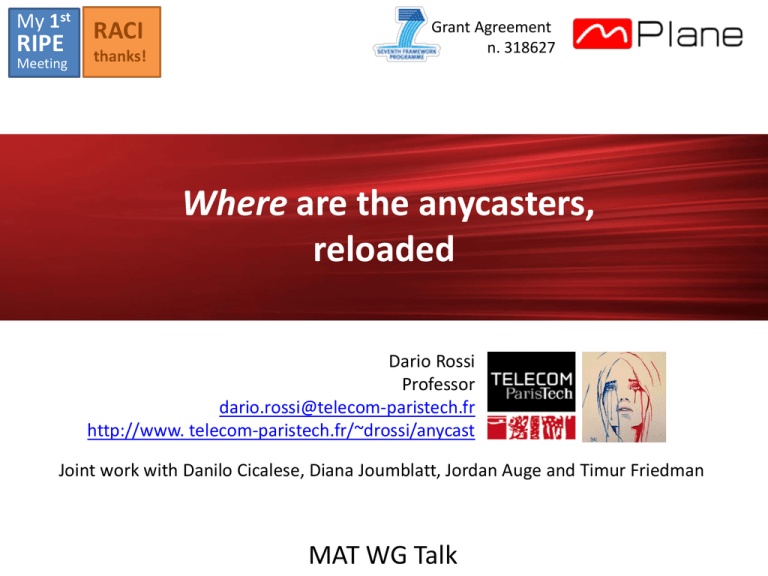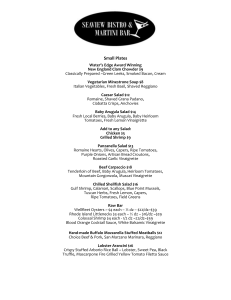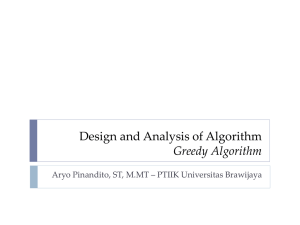pick the largest city
advertisement

My 1st RIPE Meeting RACI thanks! Grant Agreement n. 318627 Where are the anycasters, reloaded Dario Rossi Professor dario.rossi@telecom-paristech.fr http://www. telecom-paristech.fr/~drossi/anycast Joint work with Danilo Cicalese, Diana Joumblatt, Jordan Auge and Timur Friedman MAT WG Talk Agenda • Aim – Informal talk; Keep this interactive • Metodology refresh • Results, reloaded – O(1) deployments (with ground truth): Details about geolocalization technique – O(107) deployments: The dark side of the census (from an Internet scan in few hours to few minutes) • Note – Many thinks (software, web interface, etc.) already available, we of course have more (ask if interested) http://www. telecom-paristech.fr/~drossi/anycast 2 Methodology refresh Filter latency noise Scalability Detect Speed of light violations Enumerate Solve MIS Geolocate Classification Brute force (Optimum) Greedy (5-approx) Maximum likelihood pick the largest city Measure Latency Iterate Feedback Planetlab/RIPE Atlas Lightweight Measure Detect For BGP hijack detection, only detection needed; no need for hundeds VP, gain a factor of 10x Infrastructure Enumerate Geolocate Iterate 3 Methodology refresh Filter latency noise Scalability Detect Speed of light violations Enumerate For BGP hijack detection, Solve MIS only detection needed; Brute force (Optimum) no need for hundeds VP, Greedy (5-approx) gain a factor of 10x Measure Latency Measure Detect Maximum likelihood pick the largest city Iterate Feedback Planetlab/RIPE Atlas Lightweight Geolocate Classification Infrastructure Enumerate Geolocate Iterate 4 Outline Background Part I: iGreedy Part II: Census Ongoing work Summary iGreedy performance Accurate enumeration over 75% recall Precise geolocation over 75% true positives Protocol agnostic DSN and CDN, etc. Lightweight 100x less probes than previous work Consistent across measurement infrastructure Robust in spite of very noisy latency measurements! (and some odd VP geolocation) 5 Measurement campaigns Experimental results in [4] gathered with open source software and dataset Avail in the igreedy-v1.0 software package at [3] 6 Measurement campaign (1/2) Very noisy delay measurements. Only 10% of disks are smaller than 1000km !! 7 Measurement campaigns (2/2) Picking one city at random: less than 1/100 success in 90% of disks In 90% of the cases, over 100 cities in a disk Delay information: useful for enumeration, bad for geolocation !! 8 Geolocation • Classification task – Map each disk Dp to most likely city – Compute likelihood (p) of each city in disk based on: • ci: Population of city ci i di p =a + (1 - a ) j å cairport åi dj • Ai: Location of ATA of city j j • d(x,y): Geodesic distance • a: city vs distance weighting rationale: users lives in densely populated area; to serve users, servers are placed close to cities Frankfurt p=0.30 i Munich p=0.60 Zurich p=0.10 • Output policy • Proportional: Return all cities in Dp with respective likelihoods • Argmax: Pick city with highest likelihood In practice, pick the largest city is best ! (Argmax with a=1) iGreedy performance: robustness Not even need for filtering large disks, as iGreedy sorts disk by increasing size, bad disks implicitly filtered out in the solution!! 10 10 Outline Background Part I: iGreedy Part II: Census Ongoing work Summary iGreedy performance: MIS solver • MIS performance: – – – – In theory: Greedy = 5x-approximation of global optimum In practice: Greedy solution ≈ Brute Force solution Iteration introduces a significant benefit O(100ms) greedy vs O(1000sec) brute force (for ~300 nodes) In practice, greedy is good enough 11 Outline Background Part I: iGreedy Part II: Census Ongoing work Summary Vantage points impact (1/3) • Footprint Infrastructure VPs ASes Country RIPE Atlas (all) 7k 2k 150 200 139 83 ~300 180 30 RIPE Atlas (subset) PlanetLab All anycast IPv4 deployment • RIPE7k = full (at time of experiments) – Greater coverage, but artifacts due to geolocation inaccuracy • RIPE200 = selection of 200 VPs at least 100km far apart – Better than PlaneLab for fewer VPs Top-100 anycast IPv4 deployments • RIPE350 = 350VPs that have geolocation tags + those VP that yielded true positive for CDN/DNS – Best for RIPE • Union of RIPE and PlanetLab – Even better Union makes the force! 12 Outline Background Part I: iGreedy Part II: Census Ongoing work Summary Vantage points impact (2/3) • Footprint Infrastructure VPs ASes Country RIPE Atlas (all) 7k 2k 150 200 139 83 ~300 180 30 RIPE Atlas (subset) PlanetLab Vantage point Infrastructure ? • RIPE7k = full (at time of experiments) – Greater coverage, but artifacts due to geolocation inaccuracy • RIPE200 = selection of 200 VPs at least 100km far apart – Better than PlaneLab for fewer VPs (Microsoft IP/24 Example) • RIPE350 = 350VPs that have geolocation tags + those VP that yielded true positive for CDN/DNS – Best for RIPE • Union of RIPE and PlanetLab – Even better Not always :( 13 Outline Background Part I: iGreedy Part II: Census Ongoing work Summary Vantage points impact (3/3) Pretty messy. The owner of the VP We also have sets the geolocation picteures of • 500 VP have a tag PlanetLab nodes in Navajo system-auto-geoip-city reserves or • Can we trust it? swimming in • Only 350 are 100 km apart the ocean France • Spain Romanian VP gone hiking Middle of US Middle of Nowhere 14 Protocol impact Recall[%] • If multiple protocols answer, no noticeable difference in the output, however ICMP service agnostic, maximizes (*) reply (*) CloudFlare stopped replying our pings :( 15 Probing rate src • Our tool can scan more than 10k hosts/sec per src • We spread destinations with a linear shift register so to maximize interarrival time between two ICMP echo request at destination • However, ICMP echo reply aggregate at the source, that receives about 10k replies/sec • Some ingress firewalls in PlanetLab nodes think this is an attack and rate limits For BGP hijack detection, removing ICMP filters • No problem with 1k requests/sec yields a 10x speedup ! 16 ``Double’’ ping • (In lack of a better name) • Idea – try to discover something about penultimate hop without performing a full traceroute (be fast and simple) • Means – on reception of an ICMP echo reply X with TTLx – issue one ICMP echo request Y limiting the TTLy to the closest power of 2 to X – TTLx -1 – (i.e., expected number of hops minus one) • Question – Do you expect any relevant info about the penultimate AS in the path, that we can leverage Opportunistic & limited for BGP hijack detection? traceroute 17 Conclusions • iGreedy novel technique to investigate and especially geolocate anycast deployment Practical lightweight, fast and protocol agnostic Ready open-source software to issue, analyze and display RIPE Atlas measurement (using your credits!) Useful Web interface to (significant subset of) census results already available Interested ? Drop an email dario.rossi@enst.fr ! (but cc danilo.cicalese@enst.fr to get a timely reply) 18 References Plenary talk: [1] D. Cicalese , D. Joumblatt, D. Rossi, J, Auge, M.O Buob, T. Friedman. A Fistful of Pings: Accurate and Lightweight Anycast Enumeration and Geolocation , IEEE INFOCOM, 2015 [2] D. Cicalese , J. Auge, D. Joumblatt, T. Friedman, D. Rossi, Characterizing IPv4 Anycast Adoption and Deployment , ACM CoNEXT, Dec 2015 [3] http://www.telecom-paristech.fr/~drossi/anycast [4] Cicalese, Danilo, Joumblatt, Diana , Rossi, Dario, Buob, Marc-Olivier , Auge, Jordan and Friedman, Timur , Latency-Based Anycast Geolocalization: Algorithms, Software and Datasets . In Tech. Rep., 2015. 19 ?? || // !! After this slides, too many backup slides Reverse cronological order: •[4] Tech Rep: Why the largest city ? •[2] CoNEXT: Why ICMP ? What about CDN? Duration? •[1] INFOCOM: Methodology details amd comparison 20 TechRep/ Why largest city 21 TechRep/ Why largest city 22 CoNEXT/ CDN Performance 23 CoNEXT/Why ICMP 24 CoNEXT/Duration 25 INFOCOM 26 Methodology overview Detect Speed of light violations Measure Latency Planetlab/Ripe Enumerate Solve MIS Geolocate Classification Optimum (brute force) 5-approx (greedy). Maximum likelihood Iterate Feedback • PlanetLab Measure Detect Speed of light violations Measure Latency Planetlab/Ripe – 300 vantage points – Geolocated with Spotter (ok for unicast) – Freedom in type of measurement ICMP, DNS, TCP-3way delay, etc • RIPE – 6000 vantage points – Geolocated with MaxMind (ok for unicast) – More constrained (ICMP, traceroute) In this talk: min over 10 ICMP samples Enumerate Solve MIS Geolocate Classification Optimum (brute force) 5-approx (greedy). Maximum likelihood Iterate Feedbac k Detect Detect Speed of light violations Measure Latency Planetlab/Ripe The vantage points p and q are referring to two different instances if: Enumerate Solve MIS Geolocate Classification Optimum (brute force) 5-approx (greedy). Maximum likelihood Iterate Feedbac k Packets cannot travel faster than the speed of light Detect Speed of light violations Enumerate • Find a maximum independent set E Measure Latency Planetlab/Ripe – of discs such that: – Brute force (optimum) vs Greedily from smallest (5-approximation) Enumerate Solve MIS Geolocate Classification Optimum (brute force) 5-approx (greedy). Maximum likelihood Iterate Feedbac k Geolocate • Classification task Detect Speed of light violations Measure Latency Planetlab/Ripe – Map each disk Dp to most likely city – Compute likelihood (p) of each city in disk based on: • ci: Population of city i • Ai: Location of ATA airport of city i ci di • d(x,y): Geodesic p = a distance + (1 - a ) cj åweighting å dj • a: city vs distance Enumerate Solve MIS Geolocate Classification Optimum (brute force) 5-approx (greedy). Maximum likelihood Iterate Feedbac k Frankfurt p=0.30 i j j Munich p=0.60 • Output policy • Proportional: Return all cities in Dp with respective likelihoods • Argmax: Pick city with highest likelihood Zurich p=0.10 rationale: users lives in densely populated area; to serve users, servers are placed close to cities airports: simplifies validation against ground truth (DNS) Iterate Detect Speed of light violations Measure Latency Planetlab/Ripe Increase recall of anycast replicas enumeration Enumerate Solve MIS Geolocate Classification Optimum (brute force) 5-approx (greedy). Maximum likelihood Iterate Feedbac k • Collapse – Geolocated disks to city area • Rerun – Enumeration on modified input set Validation • Validation dataset – – – – 200 VPs from PlanetLab DNS CHAOS queries DNS root servers F, K, I, L City-level ground truth about sever location available • E.g., IATA code, IXPs short names • Enumeration – Impact of solver (Brute force vs. greedy, Iteration) • Geolocation – Impact of geolocation parameters (city vs distance weight, policy) Validation: Enumeration Algorithm F I K L Greedy 17 13 9 20 BruteForce 18 +6% 13 iGreedy 18 +6% 15 +15% 10 +11% 22 +10% iBruteForce 21 +23% 15 +15% 10 +11% 22 +10% Dataset CHAOS UB 22 23 11 33 Published GT 55 46 17 128 - 9 - 20 - Recall of iterative greedy solver as good as brute force iGreedy solver O(100ms) faster than brute force O(1000s) Validation: Geolocation Argmax better than proportional Distance from disc border and city population have similar weights Measurement campaign • Infrastructures – 200 PlanetLab VPs from 26 countries and105 AS – 6000 RIPE Atlas VPs from 122 countries and 2168 AS. • Additionally – 500 RIPE Atlas VPs selected uniformly at random – 200 RIPE Atlas VPs stratified selection(>100km from each other) – Same size as PlanetLab, possibly larger diversity (200/6000) • Focus – Comparison of iGreedy with state of the art – Robustness with respect to vantage point selection L root server in Europe Not shown False negative M (discarded due to disk intersection) M Number of vantage points Comparison with state of the art Overhead reduced by orders of magnitude Comparable enumeration recall [1] X. Fan, J. Heidemann and R. Govindan, “Evaluating anycast in the Domain Name System” in Proc. IEEE INFOCOM, 2013. [2] M. Calder, X. Fan, Z. Hu, E. Katz-Bassett, J. Heidemann and R. Govindan, “Mapping the expansion of Google’s serving infrastructure” in Proc. ACM IMC, 2013. Comparison with state of the art Correctly identifies location for ¾ of enumerated servers Decent geolocation error w/o filtering (recall 1ms=100Km) [1] X. Fan, J. Heidemann and R. Govindan, “Evaluating anycast in the Domain Name System” in Proc. IEEE INFOCOM, 2013. [2] M. Calder, X. Fan, Z. Hu, E. Katz-Bassett, J. Heidemann and R. Govindan, “Mapping the expansion of Google’s serving infrastructure” in Proc. ACM IMC, 2013. Qualitative comparison with CCG CCG filtering wastes 20% of measurements a posteriori Big, Big, Big caveat These numbers are not directly comparable ! Dataset and aim differ (Google infrastructure) iGreedy performance No error for 78% of replicas 271 km median error for misclassified replicas iGreedy geolocation error can be upper-bounded by filtering circles with large radius! [2] M. Calder, X. Fan, Z. Hu, E. Katz-Bassett, J. Heidemann and R. Govindan, “Mapping the expansion of Google’s serving infrastructure” in Proc. ACM IMC, 2013. Robustness to vantage point selection RIPE Atlas PlanetLab Dataset Full 6000 Unif 500 Strat 200 Full 200 iGreedy / CHAOS UB 76% 52% 73% 73% CHAOS UB / GT 80% 54% 72% 36% Geolocated 76% 63% 78% 74% Mean geolocation error (km) 333 569 361 162 Number of VPs has little impact on recall! Strategic selection of VPs is promising Summary of achievements • Detect, enumerate, & geolocate anycast replicas – Protocol agnostic and lightweight • Based on a handful of delay measurement O(100) VPs • 1000x fewer VPs than state of the art – Enumeration • iGreedy use75% of the probes (25% discarded due to overlap) • Overall 50% recall (depends on VPs; stratification is promising) – Geolocation • Correct geolocation for 78% of enumerated replicas • 361 km mean geolocation error for all enumerated replicas (271 km median for erroneous classification)

